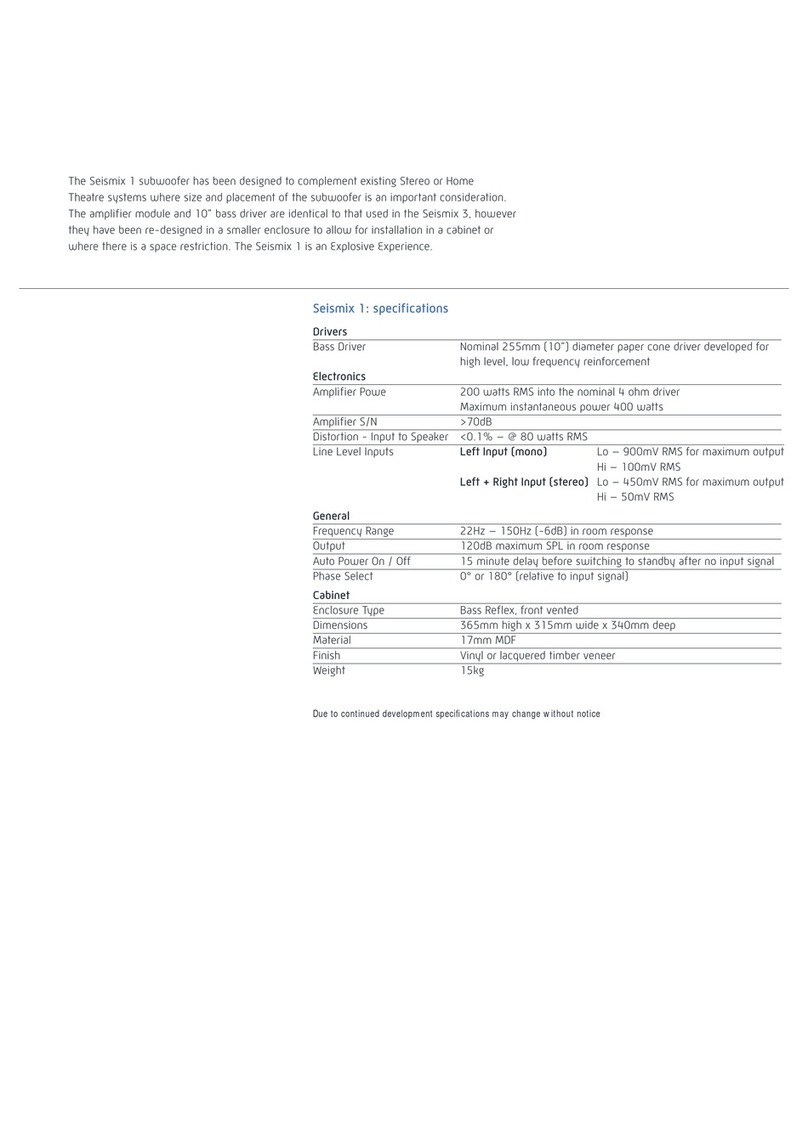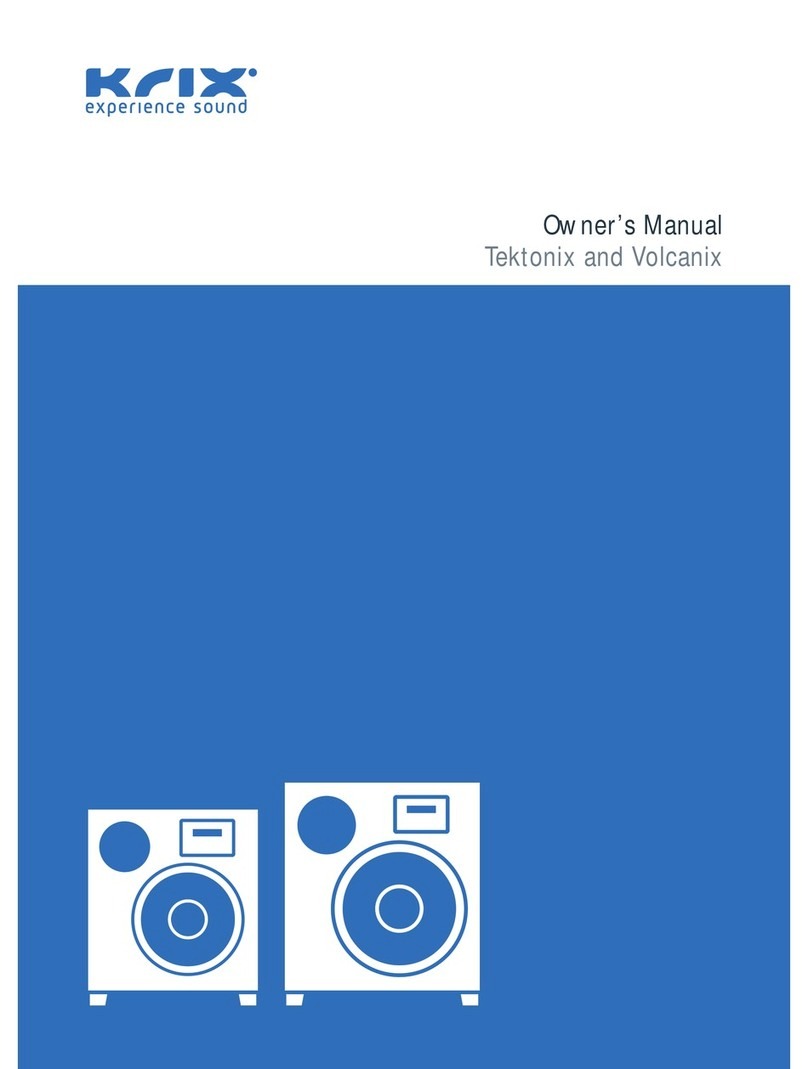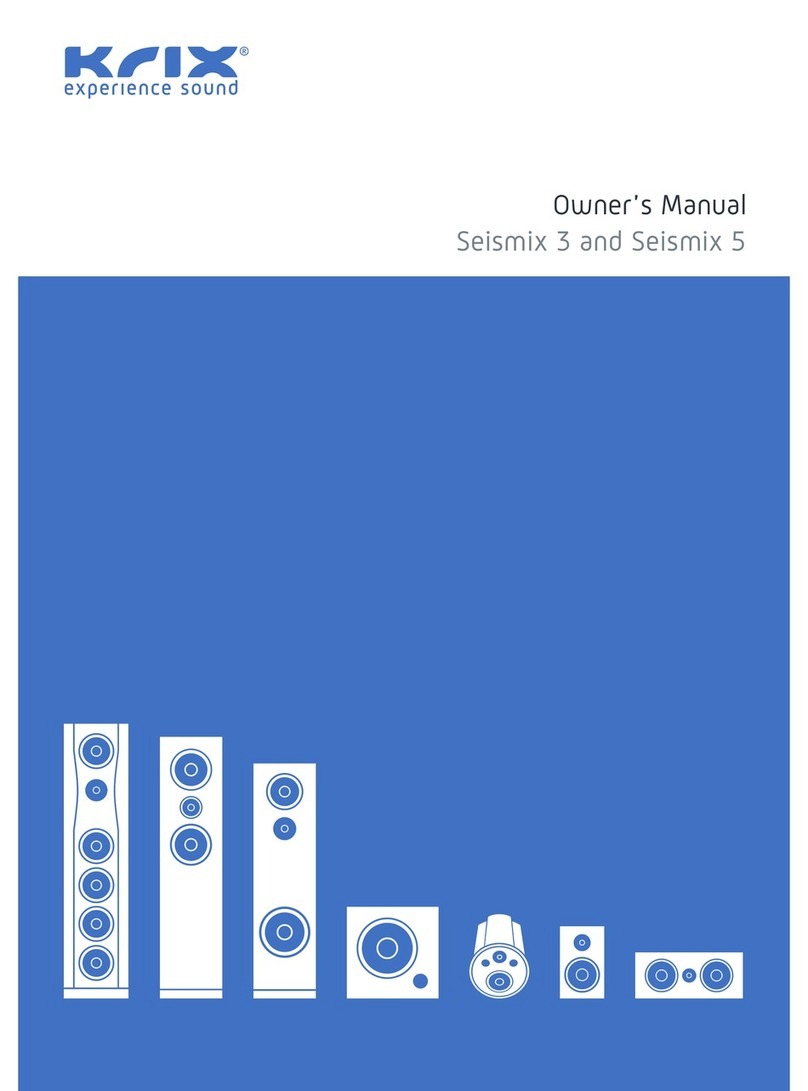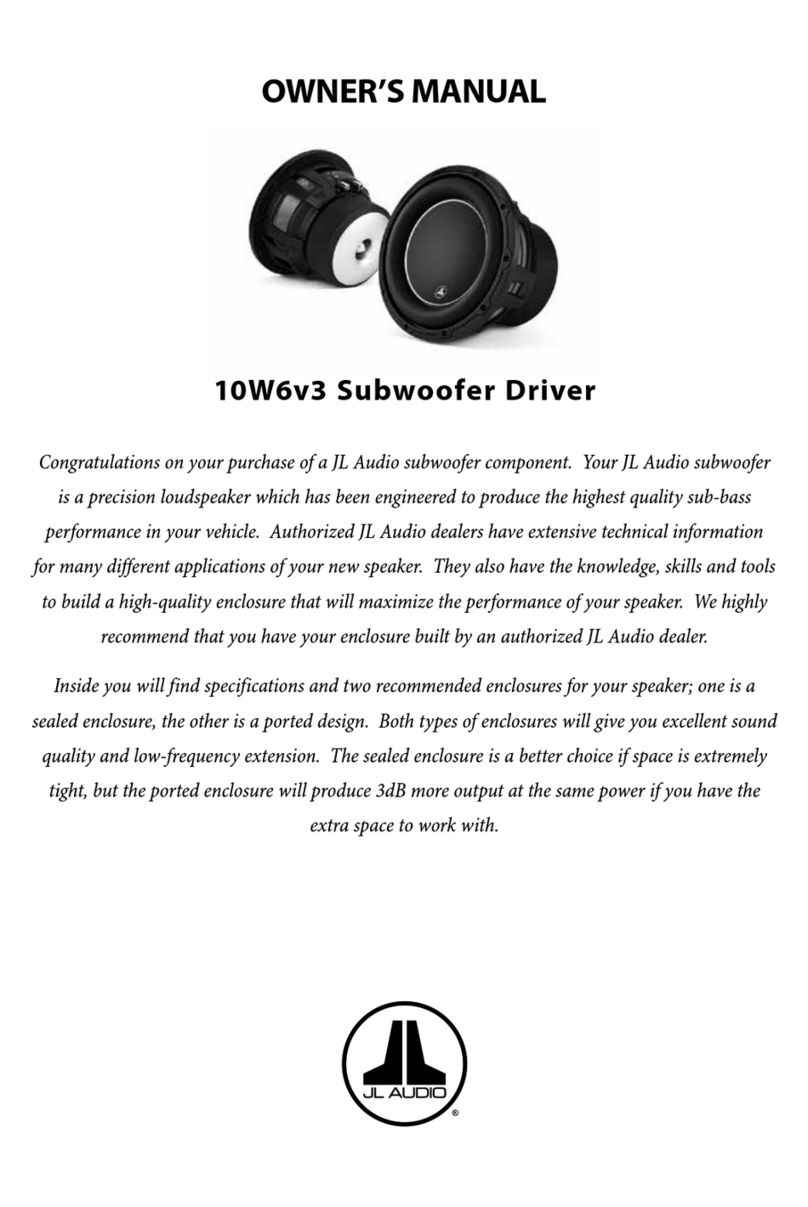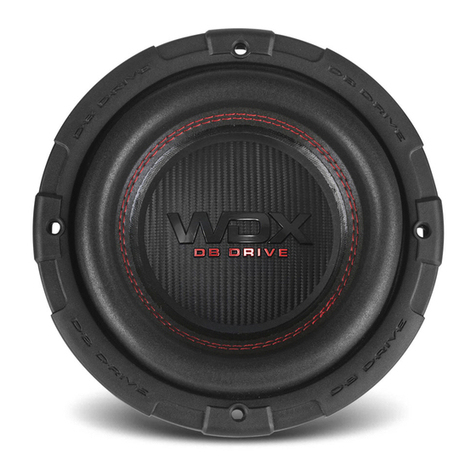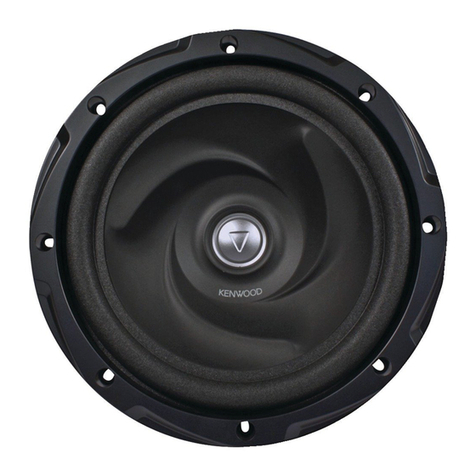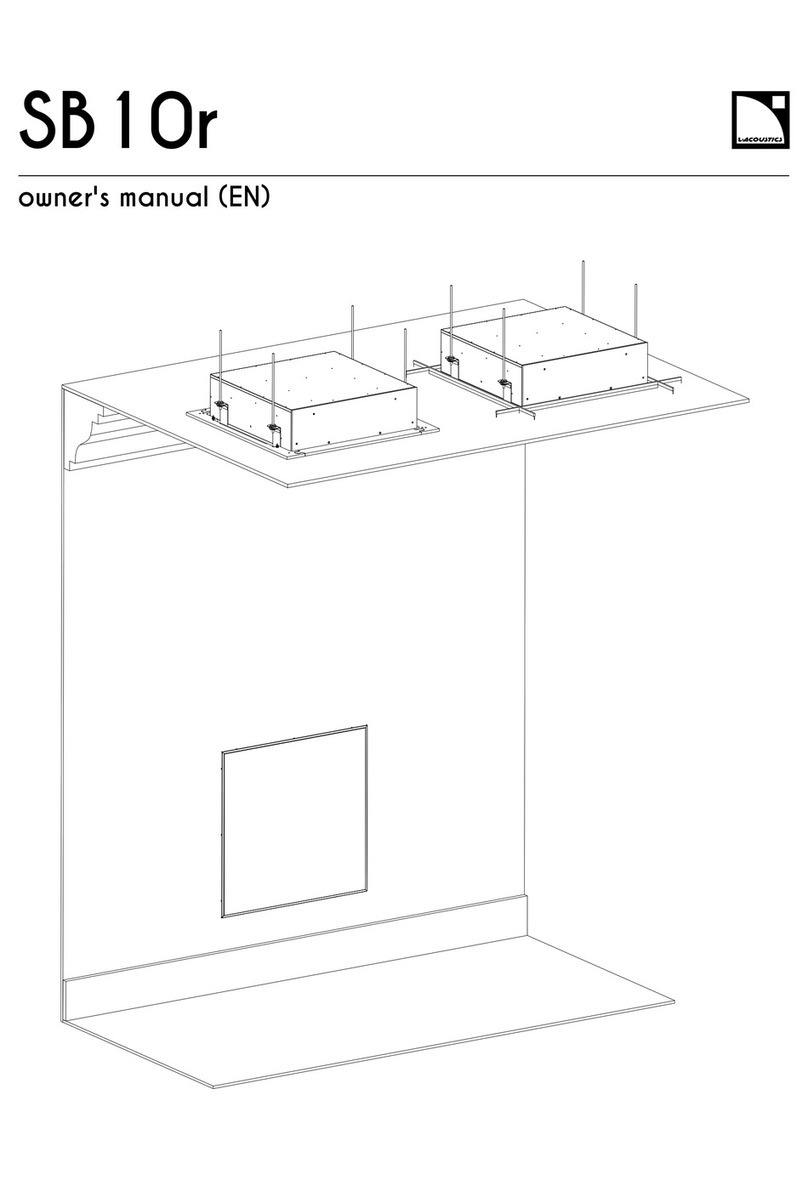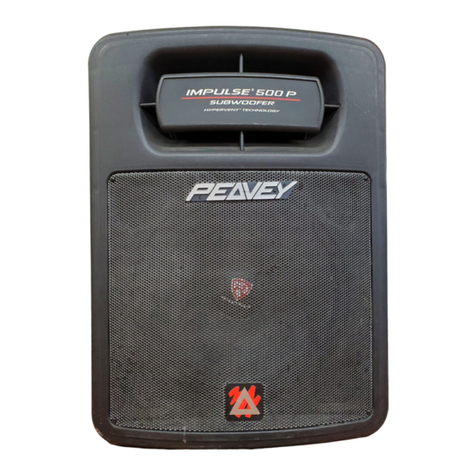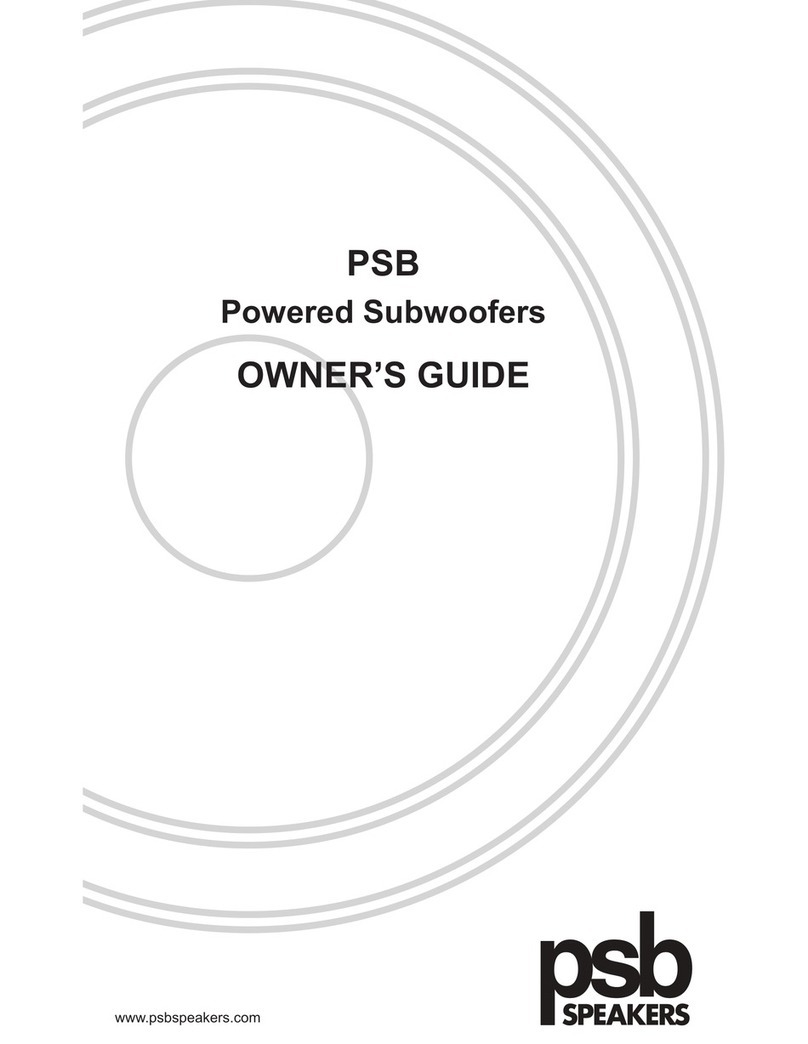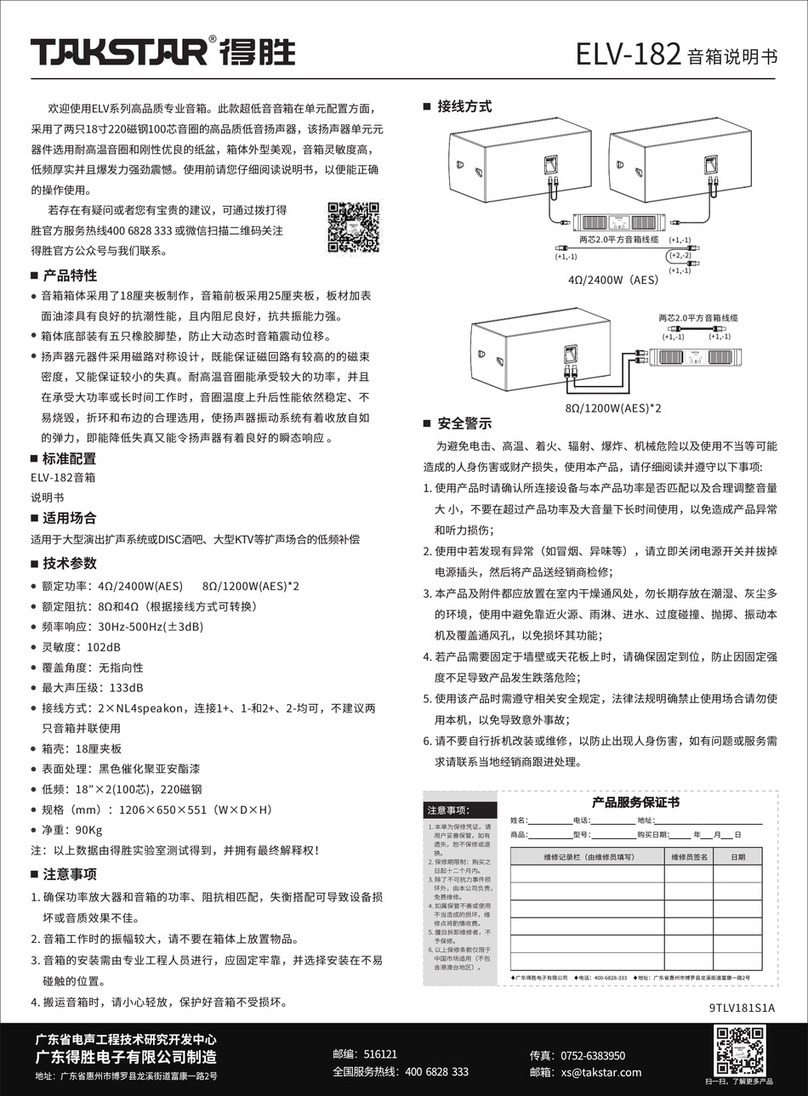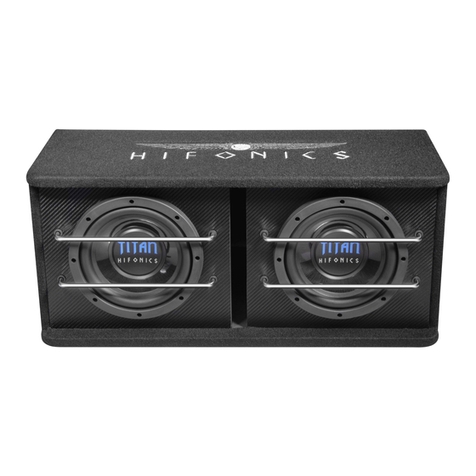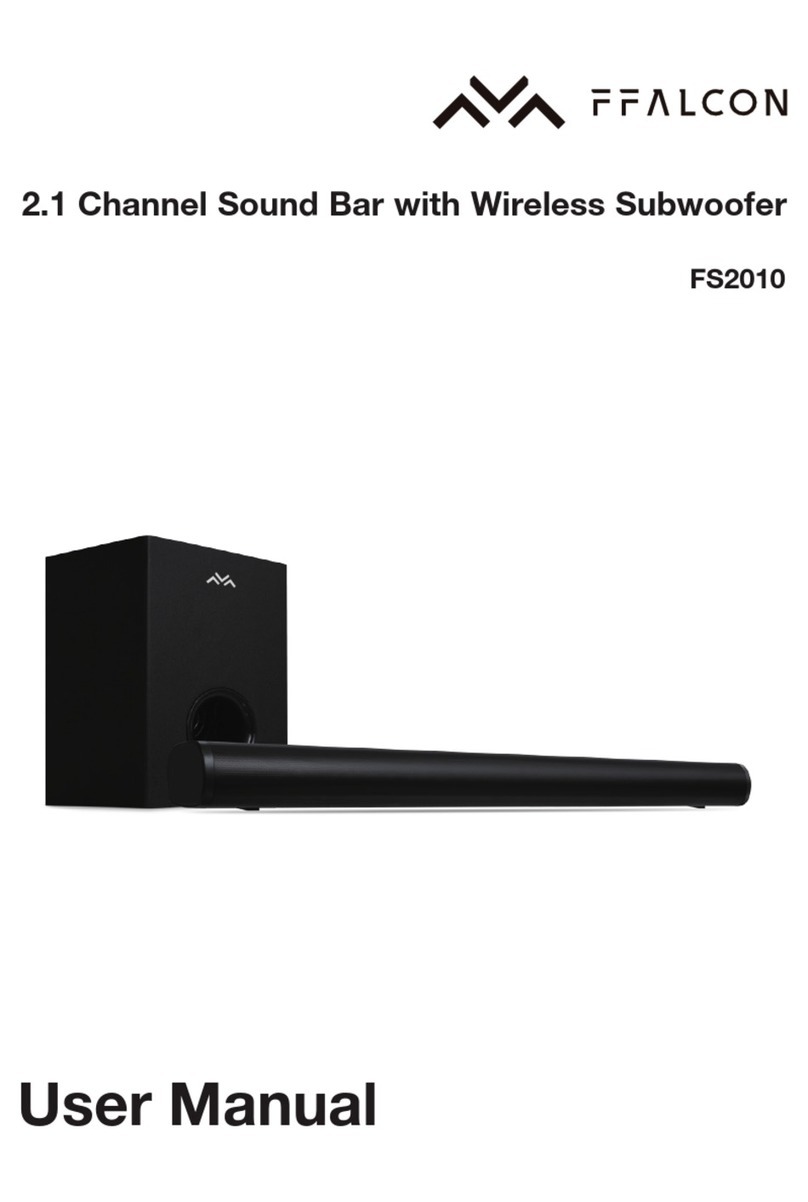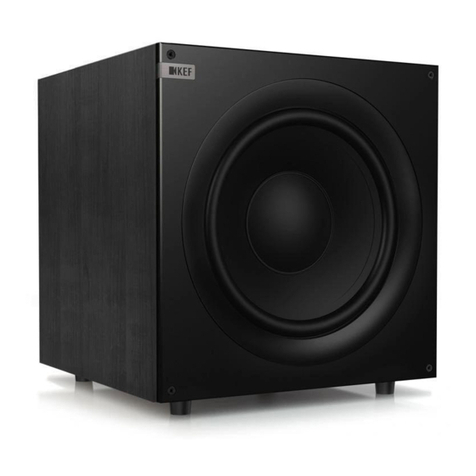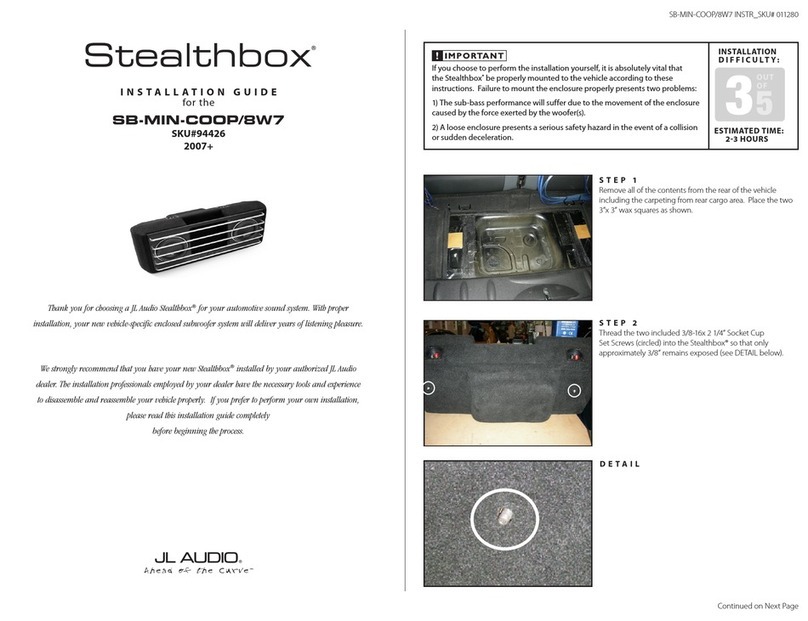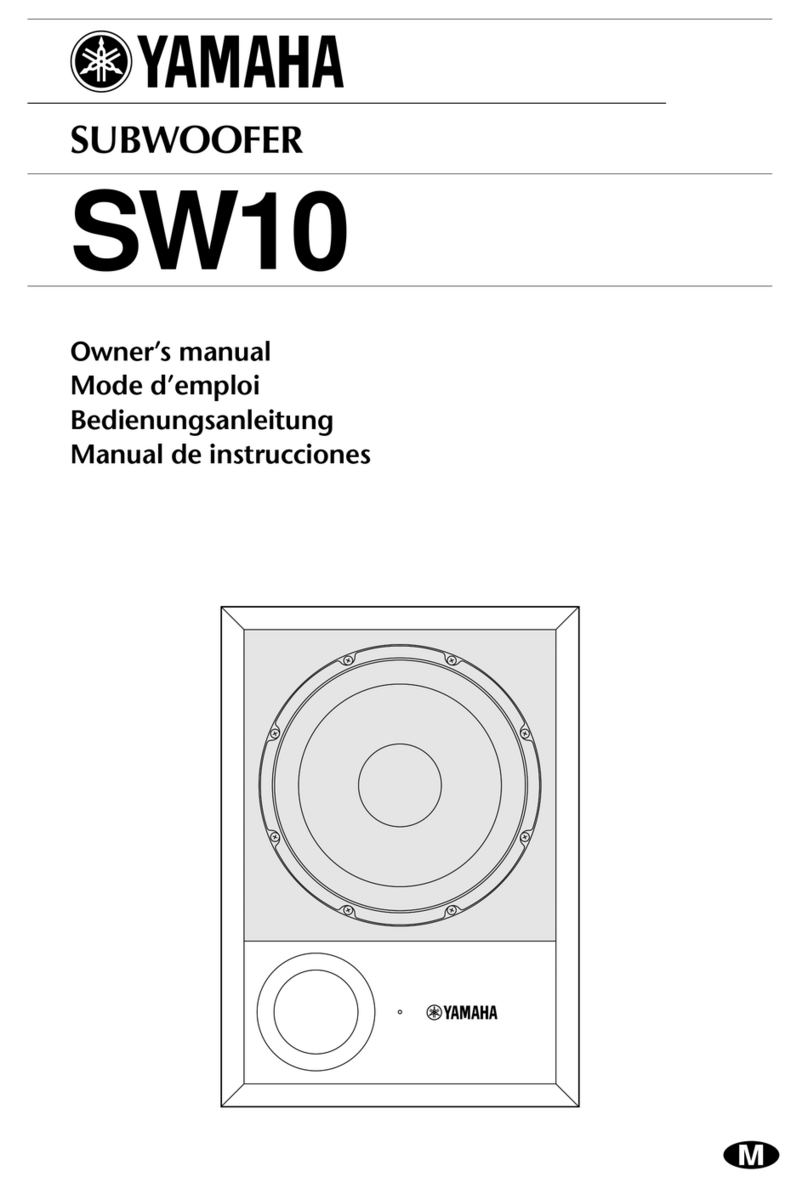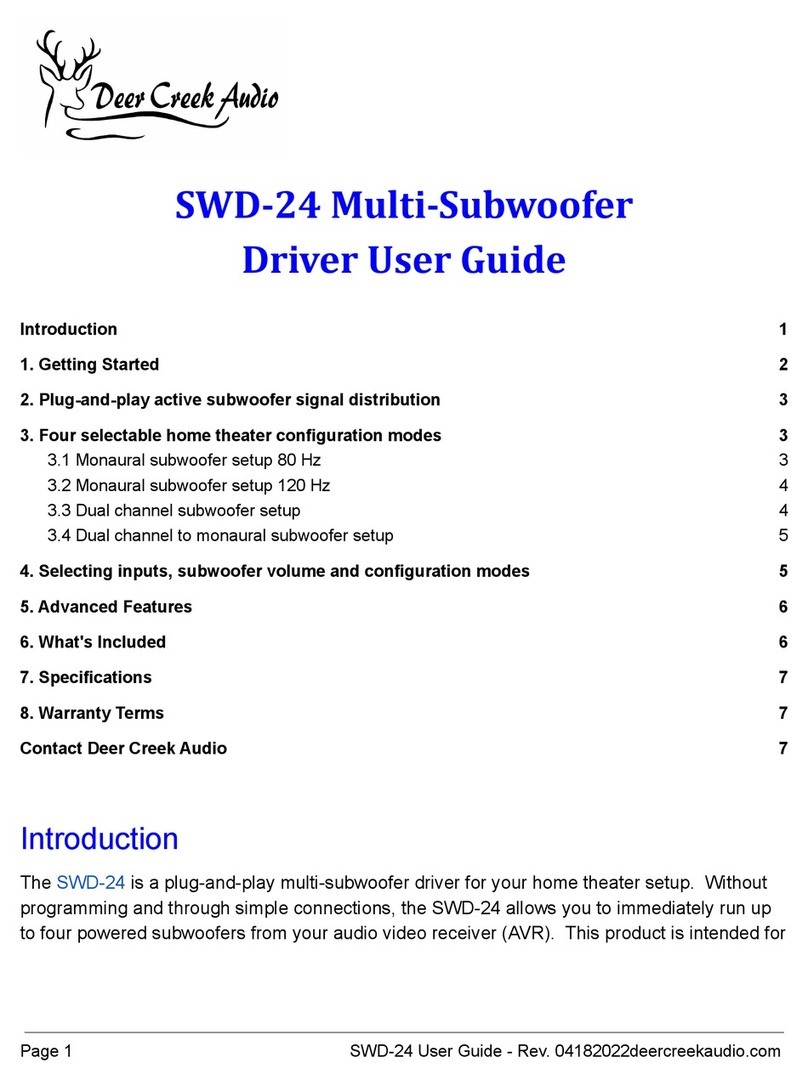Krix Seismix 1 User manual

SEISMIX 1 AND SEISMIX 3
OWNER’S MANUAL

2
Congratulations on choosing Krix
The Seismix 1 and Seismix 3 active subwoofers will complement existing stereo or home
theatre systems, improving low frequency performance for an immersive experience.
The Seismix 1 and Seismix 3 are compatible with a variety of small to large sized, sealed
or vented main speakers.
Your subwoofer is powered by an efcient class-D amplier capable of delivering maximum
output with low distortion for sustained periods of listening enjoyment. The amplier module
incorporates a switch mode power supply (SMPS) for efcient operation with less heat
generation and consistent performance regardless of mains voltage variations.
SETUP IN BRIEF
The following setup procedure will help you achieve the
best performance from your subwoofer:
1. Controls and Features
Familiarise yourself with the controls and features of your
subwoofer.
2. Positioning
Determine a suitable location for your subwoofer unit.
3. Connection and Calibration
Connect your subwoofer to your system. Listen to a variety
of music/movies to assess the sound and settings of your
subwoofer.
4. Listen and Enjoy
Listen to your favourite music/movies and enjoy.
Disclaimer
Please read the important safetly instructions on the back of this manual before you plug in your equipment.
Disclaimer
To the extent permissible by law:
1. All warranties, conditions, representations, promises and statements relating howsoever to this product whether express or implied
and whether in contract or tort are excluded to the extent permitted by law; and
2. Our liability to you under a condition or warranty (if any) implied into this sale and purchase agreement relating to this subwoofer
by the Trade Practices Act 1974 (as amended) or any other law (whether a law of Australia or any other country) other than a condition
implied by Section 69 of the said Act is limited at our option to:
- the replacement of the product; or
- the supply of an equivalent product; or
- the repair of the product.
If you do not accept the above conditions, return this product (in the original packaging) with proof of purchase for a full refund.
!

3
CONTROLS AND FEATURES
Volume
Adjusts the subwoofer’s output level.
Phase
Ajusts the phase of the subwoofer to be
between 0° (normal) and 180° (inverted).
Low Pass (Hz)
Adjusts the frequency at which higher
frequencies are ltered from the subwoofer.
Pair
Pairs subwoofer to an optional wireless
transmitter unit.
Status
White - Initialising
Red - Standby
Green - On
Blue - On with wireless in use
Yellow - Standby with wireless in use
Red Flashing - Fault condition
Input
LFE input or stereo line input

4
The most ‘obvious’ position for your
subwoofer is not always the best
The bass produced by a subwoofer is omni-
directional and very hard for your ears to
localise. Therefore a subwoofer can be
placed virtually anywhere in your listening
room and provide the impression that the
bass is radiating from your main speakers.
The quality of bass however is affected by the
position of your subwoofer due to complex
acoustic interactions with your listening
room. Depth, punch, and integration with
your main speakers are all affected by the
position of your subwoofer. Experimentation
is always recommended to achieve the most
satisfying results.
A. Often the best place for a subwoofer is in a
corner at the front of your room. This position
generally provides the maximum output
from your subwoofer. If your subwoofer
sounds excessively ‘boomy’ in this location
try moving it out 20-50cm from the corner or
along one of the adjacent walls.
B. Another option is placing your subwoofer
along the front wall of your room, within a
metre of a front speaker. In some setups this
will provide a smoother tonal balance than
corner placement. This position is particularly
good for smaller satellite/bookshelf speakers
to help integrate the sound of the subwoofer
and main speakers.
C. Some people prefer to hide their
subwoofer next to or behind a couch.
Listeners on the couch may enjoy the extra
vibrations felt through the couch, however
the bass produced from your subwoofer
may be easier to localise. Therefore it may
be harder to integrate the sound of your
subwoofer with your main speakers.
D. Placing your subwoofer away from your
walls can result in satisfying results but
maximum output from your subwoofer may
be reduced.
E. Subwoofers may also be placed inside
cabinetry. Please contact your Krix retailer
or Krix directly for suggestions with this
arrangement.
The subwoofer is not magnetically
shielded; do not place near CRT screens
(old style TVs), and magnetic media.
Avoid placing your subwoofer near
sources of heat, direct sunlight, humidly
etc.
The rear amplier panel can get hot,
ensure adequate ventilation. Read the
safety instruction on the back of this
manual for more details.
Many modern AV receivers include
automatic room correction features. It
is recommended that these correction
features are disabled until an optimal
subwoofer position has been determined.
To get the most from your subwoofer
we recommend experimenting with the
following positioning technique:
Place your subwoofer in your central
listening position, you may need to
purchase a long subwoofer input cable.
Disconnect all speakers other than the
subwoofer.
Play some music or a movie with heavy
bass content.
Move around your room, listening at
floor level. Note any changes in the
tonal quality of the bass.
Mark out one or more potential locations
that offer a smooth, extended sound or
a sound quality you enjoy. Relocate your
subwoofer to this location, reconnect
speakers, and listen again from your
central listening position. Permanently
locate your subwoofer to this new
location if you notice an improvement
in the sound quality.
POSITIONING
!
!
!
Tip
A
B
C
D
E
Tip

5
CONNECTION & CALIBRATION - AV RECEIVER
Connection and Initial Setup
• Ensure the main power switch is off and
connect the mains power cord.
• Set volume on your subwoofer to the
2/3 position.
• Set phase to 0°.
• Set subwoofer low pass to 200Hz
(bypass) setting. The AV receiver
will manage the crossover/low pass
frequency.
• Connect the subwoofer pre-out (SW) on
your receiver/processor to the LFE input
on your subwoofer. See “Advanced
connection methods” for alternatives.
• Switch on mains power switch.
• At this time you may wish to perform
the AV receiver’s automatic calibration
proceedure. After the automatic
proceedure is complete you may wish
to adjust your subwoofer output level to
taste. Alternatively refer to the manual
setup procedure below.
Manual Receiver Setup
Ensure subwoofer is set to ON or YES in
your receiver setup. Refer to your receiver/
processor manual for more information.
Use the default subwoofer channel level
setting on your receiver.
On your receiver select desired crossover
frequency/low pass setting. As a guide, use
the 80Hz setting.
If your speakers are small (bass driver
is smaller than 5 1/4”) use a higher
setting (100Hz,120Hz,150Hz) to send
more of the bass information to your
subwoofer. Consult your receiver
manual for further bass management
options and settings.
Manual Subwoofer Calibration
When experimenting with the subwoofer in a
home theatre installation it is also benecial
to listen to movies with extended periods
of low bass (explosions, rumbles etc). This
will allow you to evaluate the ‘impact’ and
‘depth’ of your subwoofer. It is also benecial
to select music that is familiar to you when
carrying out listening tests. As a suggestion,
play clean unprocessed recordings that use
double bass, bass guitar, cellos, organ or kick
drum that cover a wide bass spectrum.
Begin by playing the movie/music and slowly
adjust the volume dial on the subwoofer to
your desired level.
For nal tweaking of your subwoofer
level you may wish to sit in the primary
listening position and adjust the
subwoofer channel level using your
receiver’s remote control. Refer to your
receiver’s manual for more information
Set the phase dial. The correct phase setting
will produce the most bass. You may need to
listen to a variety of recordings to hear any
subtle change in bass energy. If no change
in bass energy can be heard between phase
settings, set phase to 0° default position. Re-
adjusted volume if necessary.
Advanced Connection Methods
One subwoofer - stereo connection
If your receiver has a stereo Lelf & Right
subwoofer output feature, connect both L
& R outputs to your subwoofers L & R line
inputs.
Two (or more) subwoofers
- mono connection
Using multiple subwoofers can be useful
in large or troublesome installations where
more uniform bass coverage is desired.
If your receiver has only one subwoofer
output, use a Y-cable or Y-adapter to allow
connection to multiple subwoofers.
Left and right subwoofers
- stereo connection
If your receiver has stereo line level subwoofer
outputs a left and right subwoofer may be
used to provide stereo low bass reproduction.
Connect each receiver sub output to the
corresponding subwoofer:
L sub out to the left subwoofer L(mono)input.
R sub out to right subwoofer L(mono) input.
Tip Tip
to AV receiver
Main AV Receiver
From L & R sub-outs
line in
L
(mono) R
Seismix subwoofer
Main AV Receiver
From sub-out(mono)
subwoofer one subwoofer two
Main AV Receiver
From L & R sub-outs
left subwoofer right subwoofer

6
Pre-out Main-in
Stereo Amplifier
L
R
CONNECTION & CALIBRATION - STEREO SYSTEM
Defaults
• Ensure the main power switch is off and
connect the mains power cord.
• Set volume on your subwoofer to the 2/3
position.
• Set phase to 0°.
• Select desired low pass (crossover
frequency) setting on your subwoofer.
As a guide set the subwoofer lowpass
to 20hz above the main speakers low
frequency limit. Refer to main speaker
specications e.g. 60Hz -20Khz speaker
would require 80Hz setting.
• Set power mode to auto (middle position).
Connection
Requires your amplier to feature L and R
pre-out connections.
• Use two Y cables to connect each
pre-out channel on your amplier
(or pre-amplier) to the corresponding
subwoofer and main amplier inputs.
If main inputs are not present on your
amplier, simply connect the pre-outputs
to subwoofer line inputs.
If your amplier does not have L & R
pre-outs you may use a “Speaker (High
Level) to Line Level Converter” to
connect to your subwoofer inputs.
Calibration
It is benecial to select music that is familiar
to you when carrying out listening tests and
calibration procedures. As a suggestion,
play clean unprocessed recordings that use
double bass, bass guitar, cellos, organ or kick
drum that cover a wide bass spectrum.
Begin by playing music and slowly adjust the
volume dial on the subwoofer to your desired
level. For nal tweaking of your subwoofer
level you may wish to sit in the primary
listening position and ask an assistant to
adjust the volume dial on your subwoofer.
Now set the phase dial. The correct phase
setting will produce the most bass. You may
need to listen to a variety of recordings to
hear any subtle change in bass energy. If no
change in bass energy can be heard between
phase settings, set phase to 0° default
position. Re-adjust volume if necessary.
You may wish to ne-tune the crossover
frequency/low pass setting. This will vary the
amount of overlap from the subwoofer to
the main speakers and increase or decrease
the level at those frequencies. The effect is
a strengthening or weakening of the upper
bass region. Unpleasant ‘woody’ or ‘chesty’
sound qualities may suggest the low pass
setting selected is too high. If the sound lacks
‘body’ the low pass setting selected may be
too low. Re-adjust low pass setting, volume
and then phase. Re-evaluate results.
!
Tip

7
Due to continued development. specications may change without notice.
Seismix 1 V6.0: Specifications
Bass Driver
Amplifier Power
Amplifier S/N
Distortion
Line Level Inputs
Frequency Range
Output
Auto Power On / Off
Phase Select
Filters
Enclosure Type
Dimensions
Material
Finish
Weight
Nominal 200mm (8”) diameter paper cone driver, 38mm long
throw voice coil, developed for high level, low frequency rein-
forcement
300 watts RMS, 600 watts maximum instantaneous power
>85dB (input to speaker)
<0.2% - @ 150 watts RMS
Left Input (mono) 300mV RMS for maximum output
Left + Right Input (stereo) 150mV RMS for maximum output
27Hz - 200Hz (-6dB) in room response
116dB maximum SPL in room response
15 minute delay before switching to standby after no input signal
0° to 180° continuously variable (relative to input signal)
Lowpass lter 50-200Hz 2nd Order
Highpass lter to limit driver excursion below 26Hz
Bass reflex, down-ring vent
375mm high (inc. feet) x 295mm wide x 320mm deep
17mm MDF
Vinyl or lacquered timber veneer
11kg
SPECIFICATION AND FEATURES
Additional Features
Symmetrical Vent
The Seismix subwoofer enclosure features
Symmetrical bass reflex venting, where the
vent exhibits the same flare radius internally
and externally. This lowers subwoofer
distortion and serves to reduce vent
turbulence or “chufng” at high drive levels.
Clipping Protection
When faced with a signal peak which is in
excess of what the Seismix can accurately
reproduce, a limiter circuit activates to reduce
the level of the signal once it passes the
preset threshold. This permits the Seismix
to perform at high levels with only a mild
reduction in the signal’s dynamic content.
Fault Protection
In the unlikely event that the amplier
experiences a fault, the status led will flash
red. If the fault persists please contact your
dealer to arrange a warranty claim or repair.
Warranty
5 years warranty applies to the cabinet and
speaker.
3 year warranty applies to the amplier and
related internal electronics.
Refer to the details on the warranty card
supplied.
Queries
If you have any queries regarding the Seismix
Subwoofer, or any other Krix product, please
contact your nearest Krix retailer or Krix
directly. Contact details are on the back cover
of this booklet.
Nominal 275mm (11”) diameter paper cone driver, 50mm long
throw voice coil, developed for high level, low frequency rein-
forcement
300 watts RMS, 600 watts maximum instantaneous power
>85dB (input to speaker)
<0.2% - @ 200 watts RMS
Left Input (mono) 300mV RMS for maximum output
Left + Right Input (stereo) 150mV RMS for maximum output
22Hz - 200Hz (-6dB) in room response
122dB maximum SPL in room response
15 minute delay before switching to standby after no input signal
0° to 180° continuously variable (relative to input signal)
Lowpass lter 50-200Hz 2nd Order
Highpass lter to limit driver excursion below 26Hz
Bass reflex, front vented
450mm high (inc. feet) x 360mm wide x 410mm deep (inc. grille)
17mm MDF
Vinyl or lacquered timber veneer
18kg
Seismix 3 V7.0: Specifications
Bass Driver
Amplifier Power
Amplifier S/N
Distortion
Line Level Inputs
Frequency Range
Output
Auto Power On / Off
Phase Select
Filters
Enclosure Type
Dimensions
Material
Finish
Weight

krix.com
Krix Loudspeakers Pty Ltd
14 Chapman Road
Hackham SA 5163
Australia
T 61 8 8384 3433
F 61 8 8384 3419
[email protected] Doc Rev #10
Please read these important safety instructions before you plug in this equipment.
Please retain these instructions for future reference.
This equipment is manufactured to a very high standard and it should give you many years of reliable service. To minimise the chance of any
problem with this equipment, take note of the following:
This equipment uses electricity at very high voltages. To avoid injury to persons, re or damage to the unit:
• Do not use the unit near water (or something with water in it) or in the rain.
• Do not allow the unit to get wet.
• Clean the unit with a dry cloth only – do not use solvents. Unplug the unit before cleaning.
• Do not plug the unit into a power source other than the one specied.
• Make sure the power cable is protected.
• Make sure the power cable is not being pinched and that it cannot be walked on.
• Never disconnect the ground prong on the mains plug.
• When removing the power plug from the power source, do not pull on the cord.
• Do not open the unit. Refer any service to qualied service personnel.
• Do not place any thing or any part of your body into the unit.
This unit may get hot when it is being used. To avoid injury to persons, re or damage to the unit:
• Do not put the unit near any heating source.
• Keep the unit out of direct sunlight.
• Make sure all ventilation openings are clear.
• Do not cover unit with blankets or any other materials.
• Do not place unit against curtains or furnishings.
This equipment is heavy. To avoid injury to persons:
• Be careful when you lift the unit.
• Install the unit on the ground so that it cannot fall onto anyone.
This equipment can cause extreme vibrations. To avoid injury to persons, re or damage to the unit:
• Do not put the unit near things that might be damaged by vibration.
• Do not put the unit near things that might be moved by vibration (for example vases, candles or glass objects).
• Do not put objects on top of the unit.
This equipment is delicate. To avoid damage to the unit:
• If it starts to make a distorted or unusual noise, turn the volume down. If that makes no difference, turn the unit off and have it
checked by qualied service personnel.
• If you are not going to use the unit for an extended period, unplug it from the wall socket.
• If there is a storm with lightning, unplug it from the wall socket.
• Never force any switches or controls. If they are difcult to operate, have the unit checked by qualied service personnel.
• Do not put any objects on the unit.
Avoid damage to your hearing. You only have one set of ears!
All sound equipment is capable of damaging your hearing or the hearing of others. Exposing your hearing to high volume levels for extended
periods of time will cause permanent hearing damage. Even short periods at extremely high levels will cause permanent hearing damage.
Children’s hearing is especially sensitive and extra care should be taken when exposing children to high volume levels. Hearing damage is
cumulative and it may be too late when you nd out that your hearing has been damaged. We recommend that you avoid long periods of
exposure at excessive volume levels.
Other manuals for Seismix 1
1
This manual suits for next models
1
Table of contents
Other Krix Subwoofer manuals
